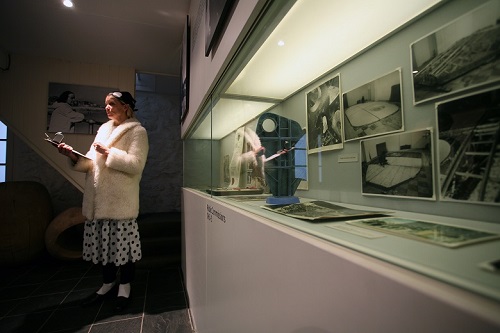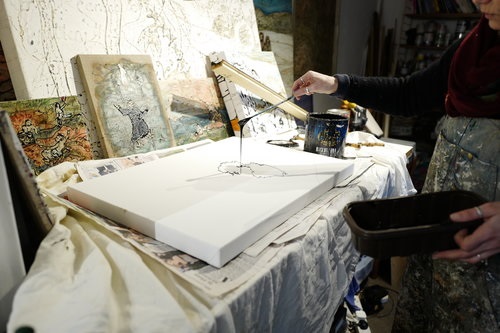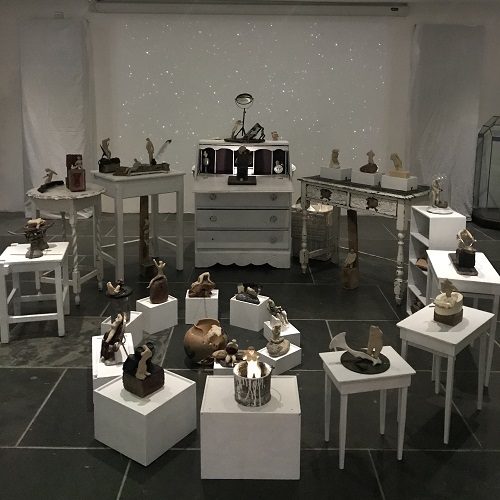|
|
| home | exhibitions | interviews | features | profiles | webprojects | archive |
|
Miss-Reading: Delpha Hudson Martin Holman
A phrase that Delpha Hudson likes comes from Christine Battersby, the British philosopher best known for her writings about feminist aesthetics. Battersby wrote that the female comprises complex, shifting identities in order to accommodate the numerous roles that culture, convention and gender has assigned to her, seldom at her own behest. The fluidity that results is multi-dimensional; the ‘self’ encompasses not only the co-existing composite of person-daughter-wife-mother but also ‘emerges [in] a relational dynamic between past, present and future’. ‘My work,’ Hudson has explained, ‘often explores new dialogues and possibilities for thinking differently about women and their representation [and hopes] to strip away layers of public expectation and preciousness.’ The process of stripping away expectations foisted on representations of women, especially so that the historically troubled duality of public professional and private carer and home-builder can be acknowledged and examined within the artwork, has driven Hudson’s search for a visual language of her own during the course of her 20-year career. What has emerged is a polyglot practice that combines and balances a variety of media, often simultaneously, as if a single form of expression cannot encompass the breadth of experience, physical and emotional, that she wants to convey. Working with performance, text, sound, painting, sculpture and installation, appropriately enough echoes the fluid identity women learn to practice in order to achieve goals of their own making in life and those engendered by society over centuries. The need to migrate across boundaries in her practice, of course, echoes the working methods of the original feminist avant-garde in the West and Japan. From the late 1950s onwards, those artists sought to make work untainted by association with male hierarchies, such as the grandstanding painters of the century’s previous progressive movements, from Cubism to Abstract Expressionism, who had populated painting and sculpture with their presence. Women were attracted to media still new to the category of visual art partly because they did not bear the male imprint so indelibly. Performance and film, documentation and photography, as well as forms of making hitherto regarded as craft-based, such as the use of textile and ceramic, brought women into the critical ambit in terms that they were helping to determine. In a similar vein, female artists colonised spaces less accustomed to being treated as art venues and, most significantly, took their gestures to the street and the public arena.
Overcoming her natural reserve, she experimented with the stage-audience encounter during her involve-ment the artist-led group Art Surgery (with Andy Whall) in 1998-2007 and in the solo performance 'Man Created the Word' (1999). The intention of that piece was to represent how language is gendered to diminish and control women’s bodies and experiences. It revolved around the ‘ritualised shedding of personae’. While standing at a table upon which objects were placed, elements that would contribute smell and sound as the performance unfolded in consecutive tableaux. First Hudson appeared in fisherman’s waterproofs to gut fish; she removed that layer of clothing to reveal a man’s pinstripe suit, in which she typed words from Genesis (‘So God created mankind in his own image…’); after which she peeled off the suit and appeared in a wedding dress. In that identity, she took a lump of lard from the table and modelled a baby in her arms. While the theme of highlighting patriarchy in order to confront it is a staple of first generation feminist art, the intrinsic value of artists’ interpretations of it derives from the acuity of its allusions and presentation. Hudson’s decision to move into open public territory for 'Pieces of Scarlet' (2001) is a memorable case in point. The performance involved the artist in a wordless public unveiling of herself from the numerous protective layers of white underwear in Birmingham’s Chamberlain Square. Indeed there are traces of Valie Export and Adrian Piper in the artist’s willingness to expose her femininity to random public attention. Hudson underlines the contradiction that in western cultures, women can be trapped by revealing themselves to the male gaze; in other societies, they are required by men to repel it by modes of dress in defence of their chastity. ‘Each piece of scarlet was a reference to the archaic tradition of women’s belief that a letter or symbol on red cloth pinned underneath clothing would keep them safe and ward off evil’, Hudson explains in reference to small token in red that she handed to passers-by as each layer was shed. ‘Not all the layers of white clothing were removed,’ she added, ’even though a small gathered to see if all would be revealed!’ – an admission in itself of women’s vulnerability to the curiosity of others. These early works incorporated the theme of exposure, even unburdening, that has continued to develop, finding alternative or parallel media for its expression. While Hudson continues to value live performance for communicating personal experience, especially of the aftermath of personal trauma and the prevalent chaos of daily life, in recent years she has brought to the forefront of her research the activities of drawing, painting, sculpture and object making. By contrast with performance, these studio practices emphasise intimacy, reflection and the private sphere. This development is typical of the opposites or contrasts that Hudson seeks to balance in her work; they are, to some degree, metaphors for the task women she believes assume in daily existence in order to cope with and make sense of their parallel professional and private selves.
Hudson has exhibited these items in different configurations. They can be hung individually, like artworks or family votives, or densely on a wall, each hanging by a string from a nail – an effect that at first suggests that somehow they are threaded together into a net-like alliance. In fact, they hang separately regardless of the combination. The absence of consistency beyond scale and strangeness brings to mind a display of charms or fetishes and, thus, recalls the thrust of the 'Pieces of Scarlet' performance, namely the investing of objects with protective superstition. The pieces appear timeless; they could belong to any century in which people have collected and assembled detritus or keepsakes for whatever reason, mostly too personal for another to decode beyond the evident intensity and investment of trust. At the same time, their roughness appears ‘artless’ with what was once called a primitive insouciance, or else they imply an Art Brut quality – the outsider art to which sophisticates might attach psychological interpretations.
Recent paintings are distinctive for the hive of detailed making on which the final surface rests. Process extends from the intricacy of drawing to the complexity of composition and on toward the application of colour. Executed on a canvas support, Hudson has adopted bitumen as a medium, dripping a viscous trail onto the primed surface (pictured above). Even more so than oil paint, bitumen is a tricky, dirty material with a strong odour that many find unpleasant. Smell and substances triggering disgust are qualities she is prepared to integrate into her work; the fish and lard she handled under lights indoors as part of 'Man Created the Word' (1999) are just one more instance. Moreover, bitumen has a long history in art, with examples of its use dating back millennia 1). It became very popular as a paint additive in the late eighteenth century and early nineteenth, especially as a glaze to set in shadow or mix with other colours to render a darker tone. Delacroix used it and perhaps the most famous example is Géricault's 'Raft of the Medusa'. His use of bitumen caused the brilliant colours to degenerate into dark greens and blacks and the paint and canvas to buckle, a risk of destruction of which Hudson is aware and even embraces: ‘Bitumen is a gestural medium and it's not going to last. It will eventually rot the canvas so the paintings have their own built-in obsolescence. There are many lines of enquiry and parallels with performance and studio practice.’ Hudson draws with a continuous thread of matter, managing to maintain the rate of flow from the stick she holds at a particular height over the canvas. She then proceeds to ‘write’ the imagery in a continuous line until the stick needs replenishing. The allusion to writing is, indeed, highly relevant to her work. She imports lines of text into these paintings that resemble fragments of a diary. The idea of a journal or diary formalises in her work the individual story that everyone carries, although it is not always written down. Nonetheless, the complexity of these private narratives constitutes, for Hudson, a ‘theatre of the self’ because it encompasses life’s numerous dramas, the events that are small scale and large, and that can scar as much as form the psyche of central protagonist, the self. 2) In history, women have been ‘written out’ more often than their lives have been given their due in the printed annals of their times. Only in recent the years has the record begun to be put straight. So, when text weaves a path around and through recent imagery, it is tempting to view the intention behind it as act of restitution. That might be going too far, especially as Hudson does not open acknowledge her authorship. Writing, however, is the undeniable unique sign of the self. Drawing, therefore, assumes a calligraphic quality to the extent that the painting assumes the artist’s ‘style’ in the way that a graphologist might identify personality traits. Forms emerge from a line and each is connected to another in a persistent flow that builds into a figurative image.
The female voices that Hudson summons up through image and text in her paintings are silent but still clamorous. There is a Babel-like quality within them of stories cutting across stories, many hard to decipher although the troubled tone is discernible. In her installation 'Small Promethean Acts' (2019), Hudson incorporates sound in the assembly of objects within a physical space where a large group of small works of stoneware clay, molded into a human form and scaled to a domestic found object. The figures relate to women and art history, but showing the body as a fragment only. Recalling the objets-textes, Hudson has included an array of objects from the home or from other locations and assigned a figure to each, locking the disrupted female forms in some ways to devices, appliances, decorations to which one might expect people to have an association, through work, home or sentiment. The spoken dimension comes from a soundtrack, played on a loop, of women retelling domestic stories from their own histories. First presented at the premises of the Hypatia Trust (pictured above), a charitable organisation in Penzance that maintains a library of published and personal documentation about the achievements of women in every aspect of their lives, the installation inevitably acquired further resonance. Hudson likes to think of her production as constantly evolving in terms of its form and materiality. Its essential fluidity in taking different shapes within a varied contexts, is emblematic of this artist’s constant progression by way of swirling eddies. From these flow energies that accumulate, alter shape and inevitably move on. © Martin Holman 2019
1) It is interesting to recall that at one time it was assumed that the bindings of Egyptian mummies used bitumen and that these became a source of pigments when decayed and dried over time. This theory may be apocryphal; the story is certainly inaccurate because bodies were not wrapped in this way. Nonetheless, the origin of the English word ‘mummy’ is from the Persian or Arabic word ‘mumia’ or ‘mumiya’ meaning asphaltum or bitumen, which may have caused some confusion about the real source of this pigment. 2) For several years, Hudson has developed a project called Theatre of the Self. It makes use of her own diary, which she started as a teenager, and which records her perceptions, emotions and experiences as she grew up. As Hudson admits, the story we have of ourselves is subject to constant revision; diaries, however, offer evidence of who we were when the entries were made. In 2017, Hudson reread these diaries, entering extracts on social media and committing what remained of the manuscript to the fire. This combined act of self-discovery, revision and cathartic liberation from the past will be documented in a publication planned for release in 2020. Sources: The artist’s words quoted in this text are taken from texts by the artist herself and by other writers included in her website www.delphahudsonartist.co.uk. Thanks to Rick Davey, photographer.
|
|
|


 Since 2008 this
dimension of her production has revolved around the accumulation of
small incidents in diverse settings, either sculpted or painted. An
early manifestation was the accumulation of ‘objets-textes’ in which,
typically, the artist arranged found oddments – buttons, stones,
figurines driftwood and numerous fragments that are hard to identify –
on an assortment of rigid supports, none so large that they could not be
easily handled and transported (pictured left). The surface of some is flat whereas the
components of others are three-dimensional, breaking any notion of
consistency or even of authorship. The content is haphazard: there may
be relationships of colour, shape, genre of object – or no obvious link
at all. Hudson has described the process of assembling these objects as
a kind of play: ‘They sit, and in passing I play, re-arranging them,
swopping items. I think, read, research what they might mean. I keep a
sketchbook, sketching different juxtapositions and jotting down words,
poems, stories, imagining materials to add, and how I might arrange text
and in what medium. Each objet-texte becomes a little world, in which
ideas are played with and re-arranged until they settle in some way.
They are never quite finished.’
Since 2008 this
dimension of her production has revolved around the accumulation of
small incidents in diverse settings, either sculpted or painted. An
early manifestation was the accumulation of ‘objets-textes’ in which,
typically, the artist arranged found oddments – buttons, stones,
figurines driftwood and numerous fragments that are hard to identify –
on an assortment of rigid supports, none so large that they could not be
easily handled and transported (pictured left). The surface of some is flat whereas the
components of others are three-dimensional, breaking any notion of
consistency or even of authorship. The content is haphazard: there may
be relationships of colour, shape, genre of object – or no obvious link
at all. Hudson has described the process of assembling these objects as
a kind of play: ‘They sit, and in passing I play, re-arranging them,
swopping items. I think, read, research what they might mean. I keep a
sketchbook, sketching different juxtapositions and jotting down words,
poems, stories, imagining materials to add, and how I might arrange text
and in what medium. Each objet-texte becomes a little world, in which
ideas are played with and re-arranged until they settle in some way.
They are never quite finished.’ Text and theory
are important to Hudson’s outlook. In interviews she cites poets,
commentators and thinkers such as Adrienne Rich, Mary Kelly, Hal Foster,
Elizabeth Grosz, Julia Kristeva, Luce Irigaray, Christine Battersby and
Gilles Deleuze. About Battersby, for instance, she singles out her
‘metaphysical arguments for fluid, gendered selfhood, making it possible
for women to exist as a Subject and move and represent themselves
differently.’ Words themselves have increasingly found their way into
her images to place figurative expressions within a written context as a
spur towards narrative or, indeed, to confirm the image's place within
an ongoing narrative. This development is particularly apparent in her
painting and in recent installations. Conceivably their form derives, in
part at least, from the experience of making the objets-textes and the
handling of numerous small objects, assembling them into potential small
stories and experiencing how small beginnings can lead to – or proceed
from – grander narratives.
Text and theory
are important to Hudson’s outlook. In interviews she cites poets,
commentators and thinkers such as Adrienne Rich, Mary Kelly, Hal Foster,
Elizabeth Grosz, Julia Kristeva, Luce Irigaray, Christine Battersby and
Gilles Deleuze. About Battersby, for instance, she singles out her
‘metaphysical arguments for fluid, gendered selfhood, making it possible
for women to exist as a Subject and move and represent themselves
differently.’ Words themselves have increasingly found their way into
her images to place figurative expressions within a written context as a
spur towards narrative or, indeed, to confirm the image's place within
an ongoing narrative. This development is particularly apparent in her
painting and in recent installations. Conceivably their form derives, in
part at least, from the experience of making the objets-textes and the
handling of numerous small objects, assembling them into potential small
stories and experiencing how small beginnings can lead to – or proceed
from – grander narratives. One series of
canvases is titled
One series of
canvases is titled